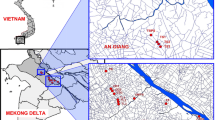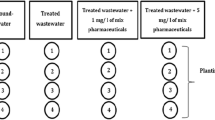Abstract
The purpose of the present study was to investigate the potential risk of herbicide contamination (2,4-dichlorophenoxy (2,4-D), 2-methyl-4-chlorophenoxyacetic acid (MCPA), metsulfuron, bensulfuron, and pyrazosulfuron) in the rice fields of the Muda Irrigation Scheme, Kedah, Malaysia. The study included two areas with different irrigation water sources namely non-recycled (N-RCL) and recycled (RCL) water. Periodic water sampling was carried out from the drainage canals during the planting period of the wet season 2006/2007 and dry season 2007. The HPLC-UV was used to detect herbicide residues in the water samples collected from the rice fields. The results showed that the concentration of sulfonylurea herbicides such as bensulfuron and metsulfuron in the rice field was 0.55 and 0.51 μg/L, respectively. The potential risk of contamination depended on the actual dosage of each herbicide applied by farmers to their rice fields. The potential risk of water pollution by the five herbicides studied in the area with RCL water tended to be more widespread compared to the area with N-RCL water due to surface water runoff with higher levels of weedicides to the surrounding areas. During the two seasons, 50–73 % of the water samples collected from the area receiving RCL water contained the five herbicides studied at concentrations of more than 0.05 μg/L, and this percentage was higher than that from the areas receiving N-RCL water (45–69 %). During the wet season, the overall total mean concentration of the eight herbicides found in the samples collected from the area with RCL water (6.27 μg/L) was significantly higher (P < 0.01) than that from the area receiving N-RCL water (2.39 μg/L). Meanwhile, during the dry season, there was no significant difference (P > 0.05) in the herbicide concentrations between the areas receiving RCL (6.16 μg/L) and N-RCL water (7.43 μg/L) water.



Similar content being viewed by others
References
Anon. (2009). Malaysian Agricultural and Directory Index 2009/2010 (12th ed.). Petaling Jaya: Agriquest Sdn. Bhd.
Ayano, E., Kanazawa, H., Ando, M., & Nishimura, T. (2004). Determination and quantitation of sulfonylurea and urea herbicides in water samples using liquid chromatography with electrospray ionization mass spectrometric detection. Analytica Chimica Acta, 507, 211–218.
Blair, A. M., Martin, T. D., Walker, A., & Welch, S. J. (1990). Measurement and prediction of isoproturon movement and persistence in three soils. Crop Protection, 9, 289–294.
Bouman, B. A. M., Castañeda, A. R., & Bhuiyan, S. I. (2002). Nitrate and pesticide contamination of groundwater under rice-based cropping systems: past and current evidence from the Philippines. Agriculture Ecosystem and Environment, 92, 185–199.
Capel, P. D., & Larson, S. J. (2001). Effect of scale on the behavior of atrazin in surface water. Environmental Science and Technology, 35, 648–654.
Cerejeira, M. J., Viana, P., & Batista, S. (2003). Pesticides in Portuguese surface and ground waters. Water Research, 37, 1055–1063.
Cheah, U. B., & Lum, K. Y. (1994). Pesticide residues and microbil contamination of water resources of rice in Muda area. In: B. M. Nashriyah, K. Y. Lum & B. S. Ismail (Eds.), Proceeding of the Seminar on Impact of Pesticides on the Rice Agroecosystem in the Muda area. Pulau Pinang, 12–13 December 1994.
Cheah, U. B., & Lum, K. Y. (1998). Pesticide residues and microbial contamination of water resources in the Muda rice agroecosystem. In B. M. Nashriyah, N. K. Ho, B. S. Ismail, A. B. Ali, & K. Y. Lum (Eds.), Rice agroecosystem of the Muda Irrigation Scheme, Malaysia (pp. 200–206). Bangi: MINT-MADA.
Cole, J. T., Baird, J. H., Basta, N. T., Huhnke, R. L., Storm, D. E., Johnson, G. V., Payton, M. E., Smolen, M. D., Martin, D. L., & Cole, J. C. (1997). Influence of buffers on pesticide and nutrient runoff from bermudagrass turf. Journal of Environment Quality, 26(1), 589–598.
Deschamps, F. C., Noldin, J. A., Eberhardt, D. S., Hermes, L. C., & Knoblauch, R. (2003). Agrochemicals residues in water from rice production areas, in Santa Catarina State, Brazil. In: Brazilian Rice Congress, 3. Camboriú, 2003. Proceedings. Camboriú. p. 683–685.
Ding, W. H., Liu, C. H., & Yeh, S. P. (2000). Analysis of chlorophenoxy acid herbicides in water by large-volume on-line derivation and gas chromatography–mass spectrometry. Journal of Chromatography A, 896, 111–116.
Gonzalo, E. R., Laespada, M. E. F., & Seronero, L. C. (2003). Evolution over time of the agricultural pollution of waters in an area of Salamanca and Zamora (Spain). Water Research, 37, 928–938.
Hamilton, D. J., Ambrus, A., Dieterle, R. M., Felsot, A. S., Harris, C. A., Holland, P. T., Katayama, A., Kurihara, N., Linders, J., Unsworth, J., & Wong, S.-S. (2003). Regulatory limits for pesticide residues in water. Pure and Applied Chemistry, 75(8), 1123–1155.
Harada, J. (2001). Research in the 21st century for weed scientists in the Asia-Pacific region and roles of the new journal Weed Biology and Management: a message from the President. Weed Biology and Management, 1, 1–4.
Ho, N. K. (1998). The rice agroecosystem of the Muda Irrigation Scheme: an overview. In B. M. Nashriyah, N. K. Ho, B. S. Ismail, A. B. Ali, & K. Y. Lum (Eds.), Rice agroecosystem of the Muda Irrigation Scheme, Malaysia (pp. 3–24). Bangi: MINT-MADA.
Huber, A., Bach, M., & Frede, H. G. (2000). Pollution of surface waters with pesticides in Germany: modeling non-point source inputs. Agriculture Ecosystem and Environment, 80, 191–204.
Ismail, B. S., & Khalithasan, K. (2002). Measurement and prediction of permethrin persistence in six Malaysian agricultural soils. Australia Journal of Soil Research, 40, 1–10.
Ismail, B. S., Noor Faezah, Z., & Ho, N. K. (1998). Weed population and their buried seeds in rice field of the Muda area. In B. M. Nashriyah, N. K. Ho, B. S. Ismail, A. B. Ali, & K. Y. Lum (Eds.), Rice agroecosystem of the Muda Irrigation Scheme, Malaysia (pp. 49–60). Bangi: MINT-MADA.
Ismail, B. S., Enoma, A. O., Cheah, U. B., Lum, K. Y., & Zulkifli, M. (2002). Adsorption, desorption and mobility of two insecticides in Malaysia agriculture soil. Journal of Environmental Science and Health B, 3(4), 355–364.
Kolpin, D. W., Thurman, E. M., & Linhart, S. M. (2000). Finding minimal herbicide concentration in ground water? Try looking for their degradates. Science of the Total Environment, 248, 115–122.
Kuivila, K. M., & Foe, C. G. (1995). Concentrations, transport and biological effects of dormant spray pesticides in the San Francisco Estuary, California. Environmental Toxicology and Chemistry, 14(7), 1141–1150.
Lee, D. J., Senseman, S. A., O’Barr, J. H., Chandler, J. M., Krutz, L. J., & Mccauley, G. N. (2004). Soil characteristics and water potential effects on plant-available clomazone in rice. Weed Science, 52, 310–318.
Machado, S. L. O., Marchezan, E., Righes, A. A., Carlesso, R., Villa, S. C. C., & Camargo, E. R. (2006). Water use and nutrients and sediments losses on the initial water drainage on flooded rice. Ciência Rural, 36(1), 65–71.
Merkle M. G., & Bovey R. W. (1974). Movement of pesticides in surface water. In: W. D. Guenzi (Ed.), Pesticides in soil and water. Wisconsin: Madison. p. 99–105.
Miller, G. T. (2004). Sustaining the Earth, 6th Ed., Chapter 9 (pp. 211–216). Los Angeles: Thompson learning.
Pane, H., Mansor, M., & Ho, N. K. (1998). The invasion of Leptochloa chinensis (L.) Nees in the Muda area. In B. M. Nashriyah, N. K. Ho, B. S. Ismail, A. B. Ali, & K. Y. Lum (Eds.), Rice agroecosystem of the Muda Irrigation Scheme, Malaysia (pp. 61–71). Bangi: MINT-MADA.
Pena, A. L. S., & Silveira, M. I. N. (1997). Determination of chlorophenoxy herbicides in water by capillary gas chromatography with ion trap detection. Journal of Chromatography A, 758, 324–331.
Rajan, A. (2002). Integrated weed management for sustainable rice production: concept, perspectives and options. In B. M. Nashriyah, N. K. Ho, B. S. Ismail, A. B. Ali, K. Y. Lum, & M. B. Mansor (Eds.), Sustainable rice production in Malaysia beyond 2000 (pp. 75–98). Bangi: MINT-MADA.
Tran, A. T. K., Hne, R. V., Pablo, F., Day, W. R., & Doble, P. (2007). Optimisation of the separation of herbicides by linear gradient high performance liquid chromatography utilizing artificial neural networks. Talanta, 71, 1268–1275.
Ueji, M., & Inao, K. (2001). Rice field herbicides and their effects on the environment and ecosystems. Weed Biology and Management, 1(1), 71–79.
Vink, M., & Van Der Poll, J. M. (1996). Gas chromatography determination of acid herbicides in surface water samples with electron-capture detection and mass spectrometric confirmation. Journal of Chromatography A, 733, 361–366.
Wells, M. J. M., & Yu, L. Z. (2000). Solid-phase extraction of acidic herbicides. Journal of Chromatography A, 885, 237–250.
Zanella, R., Primel, E. G., & Martins, A. F. (2000). Development and validation of a high-performance liquid chromatographic method for the determination of clomazone residues in surface water. Journal of Chromatography A, 904, 257–262.
Zanella, R., Primel, E. G., Machado, S. L. O., Gonçalves, F. F., & Marchezan, E. (2002). Monitoring of the herbicide clomazone in environmental water samples by solid-phase extraction and high-performance liquid chromatography with ultraviolet detection. Chromatographia, 55, 573–577.
Zoschke, A., & Quadranti, M. (2002). Integrated weed management: Quo vadis? Weed Biology and Management, 2(1), 1–10.
Acknowledgments
This research was sponsored by UKM (Research Grant No. STGL 001-2006 and UKM-GUP-ASPL-07-05-005). The authors wish to express their utmost appreciation to Dr. Tu Poc Tuong and Dr. David Johnson from IRRI.
Author information
Authors and Affiliations
Corresponding author
Rights and permissions
About this article
Cite this article
Ismail, B.S., Prayitno, S. & Tayeb, M.A. Contamination of rice field water with sulfonylurea and phenoxy herbicides in the Muda Irrigation Scheme, Kedah, Malaysia. Environ Monit Assess 187, 406 (2015). https://doi.org/10.1007/s10661-015-4600-9
Received:
Accepted:
Published:
DOI: https://doi.org/10.1007/s10661-015-4600-9




